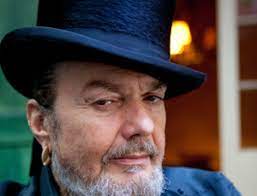Long before he unveiled the persona of “Dr. John, the Night Tripper” in 1968, Malcolm John Rebennack, Jr., was known as a gifted and precocious guitar player, pianist and songwriter around New Orleans and Los Angeles. Rebennack, whose ancestry is French and Irish, is descended paternally from Acadians who settled in Louisiana 200 years ago. He was raised not far from Louis Armstrong’s birthplace, and his father, who owned an appliance store and record shop, cultivated an appreciation in young Mac for Armstrong, Jelly Roll Morton, and other New Orleans jazzmen.
Big Mac’s connections provided an entree for his son’s youthful entry into the world of New Orleans recording studios. At Cosimo’s on North Rampart Street, he effectively crossed the Crescent City’s severe color line, and after running afoul of the musician’s union for taking cash payments on dates with Ace Records, he joined Local 178 in 1958 at the age of 17. While still in parochial school, Mac played on records by Earl King, Shirley & Lee, Art Neville, and Johnny Adams, and gained his first experience as a producer and A&R man. Notwithstanding drug problems and occasional run-ins with the law, he’s been incredibly busy ever since.

One of his early idols was Professor Longhair, whom Rebennack pithily called “the Bach of Rock,” and credited with putting “funk into music.” In 1959, he played guitar on Fess’s classic recording “Mardi Gras in New Orleans,” and 20 years later played a crucial role on Longhair’s critically acclaimed final album, Crawfish Fiesta. Here he is with Clint Eastwood discussing Fess and other “seriously good” New Orleans piano professors, followed by rare footage of Fess himself singing “Tipitina.”
We know Dr. John best as a pianist, but that’s primarily due to a mishap that occurred in 1961. As Mac relates here in a video interview with Time, he came upon his 17-year-old colleague Ronnie Barron being pistol-whipped in Jacksonville, Florida, and when he entered the fray he was shot in the hand and lost part of his left ring finger. While the finger was surgically reattached, his ability to play guitar was hampered, so he began concentrating on piano, an instrument he’d begun playing as a toddler. With Longhair as his primary model, and a few organ lessons from the legendary James Booker, he developed the keyboard mastery by which he’s become a veritable repository of New Orleans music, and over the past 15 years, a highly original interpreter of the music of Duke Ellington and Johnny Mercer. Who knows but that Mac’s run-in with a firearm resulted in his establishing a more distinct and renowned identity as a pianist than he would have enjoyed in the crowded world of guitar players?
The Doctor still manages to play guitar on occasion, and here he is in 2010 looking sharp and sounding fine on the Earl King’s NOLA classic, “Let the Good Times Roll.” The camera work’s strictly amateur, but the playing, as always, is deep and knowing.
As for Ronnie Barron, it was around Mac’s fellow New Orleanian that he conceived the idea of Dr. John Creux, the name of a 19th Century voodoo practitioner. Rebennack hadn’t done much singing over the first decade of his career, whereas Barron was an amazingly gifted soul stylist who’d already created a persona he called “Reverend Ether.” But he apparently wasn’t comfortable trading on voodoo mythology, so he declined the role of The Night Tripper. Barron enjoyed a measure of success in the ’70’s as a member of Paul Butterfield’s Better Days, where his feature was “Broke My Baby’s Heart.” Here’s a solo rendition.
Barron died in 1997 at the age of 53. Dr. John and the Blind Boys of Alabama are in concert tonight at UMass, and on Saturday at UConn.
Here’s a clip of the Blind Boys in 1963 featuring its founder, the hugely influential singer Clarence Fountain, and guitarist Joey Williams on “Too Close to Heaven.” That’s Sister Rosetta Tharpe off to the left holding her guitar.